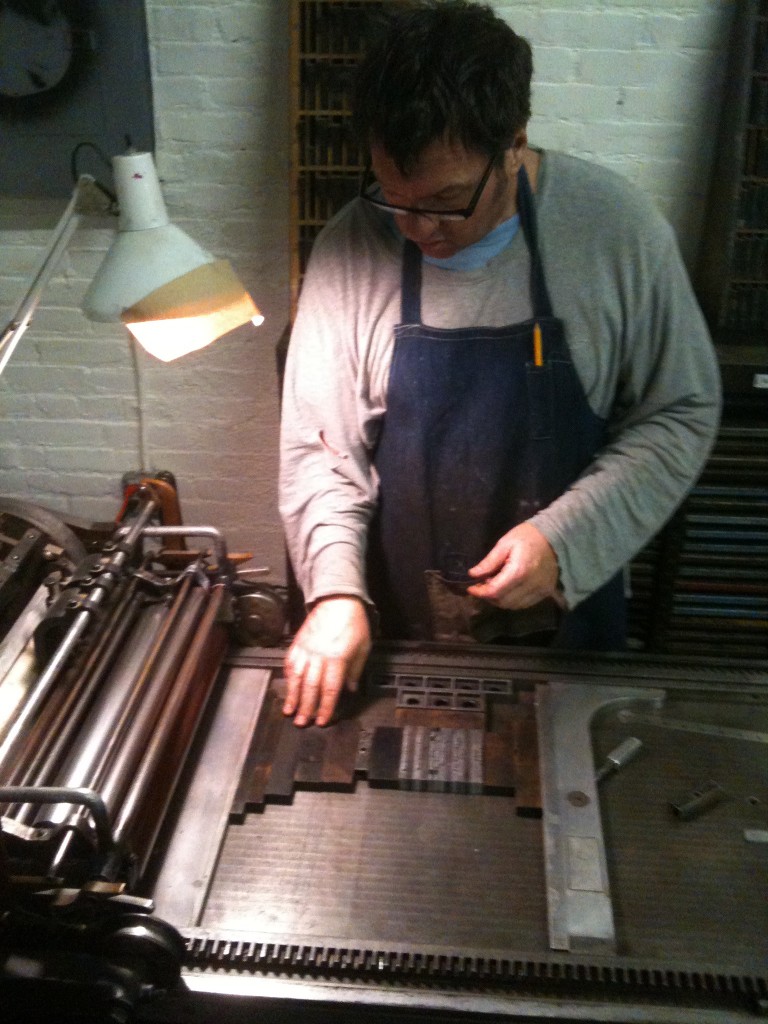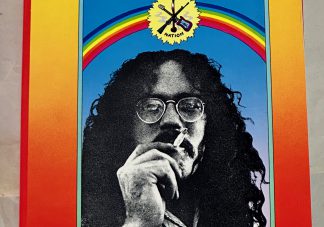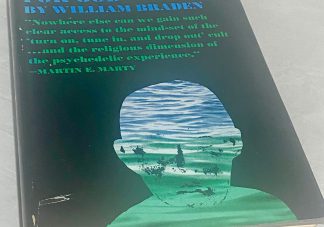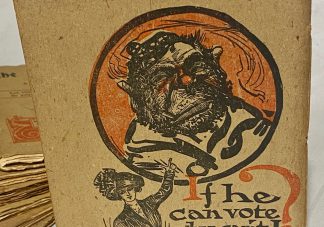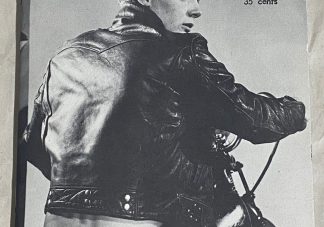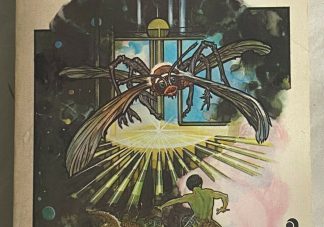Author: Jim
In Memoriam :: Allan Milkerit
About 2 hours ago I found out my good friend Allan Milkerit died; he passed a little over a year ago. Allan was a San Francisco Bookman.
Allan Milkerit taught me books.
He was one of the best.
I met him while I was in grad school; he was running the show on the third floor of a building in the Mission District of San Francisco. You’d never know it was a building full of books, cause the ground floor was a paint store, and the neighborhood wasn’t the kind you’d think of when you thought about used books.
Does that make any sense?
I had some student loan money, so I started scouting books as a job…and I needed a place to sell them. Allan was, for all intensive purposes, running the show at a place called “Tall Stories”. It was a used book co-op, right down the hall from the great Bolerium Books, as well as Meyer Boswell. Bolerium sells Leftist / Commie / Gay / Socialist Literature, and Boswell sells important and antiquarian books on Law.
The first time I met Allan, he was behind the counter, and he was schooling someone on Ed Abbey first editions. The next time I went in there, I built up the nerve to ask Allan if I could rent 3 shelves for my stuff.
He sized me up and asked my area of specialization.
“Modern firsts,” I said.
He scoffed and said something like, “join the club.”
We became fast friends. He even made some space for me in his glass case, where he kept the good stuff. I hadn’t even been there a week.
Soon, Fridays became “Meat On A Stick” day, and we’d hit some of The Mission’s classier joints for just that: meat…on a stick.
Or pizza.
Or burritos.
Usually with John, who collected baseball books, and was Allan’s friend to the end.
One of my best scores as a bookman came one day when this nutty dude who used to edit a zine dedicated to jazz music came into Tall Stories on a day I manned the counter. If you manned the counter, you got to buy. Nutty Dude had six letters William S. Burroughs had written to him, and they were great. The best one was a two page letter that started out something like this: The Last Three-Toed Sloth seen alive was hanging from a tree in Brazil before the white man put a bullet in its head…
Of course I’m remembering a letter that I read over a decade ago, so I’m sure it didn’t say that exactly, and I gladly paid Nutty Dude the $140 he wanted for the lot of 6 letters. Allan walked in, looked at them, offered me $400, and I gladly sold: I really thought I was doing great turning a $260 profit in 10 minutes.
Do I need to tell you how The Superior Bookman did with his buy?
Allan knew — and loved — Ed Abbey, photoplay editions, Ferlinghetti’s Pocket Poets series (the only known complete run sat on a shelf in Allan’s bedroom), everything about Ann Tyler, and movies.
Allan loved the movies.
Allan drove me crazy, too: half-filled cups of coffee so old they looked like a science project; his stubborn behaviors; his ability to kick my ass in the Frisbee Game we used to play in the hall when no one was around.
I wish I could figure out how time works, and how I can go so long without calling an old friend to see how he’s doing, but how it can seem like yesterday we hung out, and ate Meat On A Stick, and talked about how the internet was killing the Independent Book Store, and how he wasn’t sure if he was going to be able to survive.
I just wish I would have been there more for him.

In Memoriam :: Norman Mailer
Volta
Volta is my homage to Wallace Berman.
It’s also an assemblage and a little magazine that’s published whenever I can make it happen.
I named it after James Joyce’s one and only (failed) business venture. It was called The Volta Theater. The Volta was located at 45 Mary Street in Dublin. Opened in 1909, it was Ireland’s very first movie house. Although the very first movie to ever screen in Ireland didn’t take place at The Volta. Which is probably why it failed? I mean it takes a really shitty businessman to open a movie theater in 1909 only to have it fail. Thank goodness. What if The Volta was a success?
Some have even claimed The Volta as myth, as far as it being Ireland’s very first movie house, but that really doesn’t matter, does it?
The first issue of Volta was published in an edition of 50 copies, all of which were sent to the friends, the enemies, and the heroes of the synaesthesia press.
Essentially Volta is a junk shop of sorts, as I take whatever paper scraps I have laying around from completed projects, found scrap paper from thrift stores, and various found objects that I’ve yet to use, and then I just run ’em through one of my presses — after I set the type and proofed it all.
Contents for the first Volta include poems by Bukowski, Brautigan, Litzsky, Denander, and Catlin; there’s one of the many “overs” I had in my archives of the Childish woodcuts that accompanied “The Strangest One of All“, as well as an assemblage / found piece by Jim Pritchard.
John Martin called Volta a “brilliant little piece of publishing”, which made me squeal like a little girl; I squealed a bit louder when he sent me 6 Bukowski poems for future issues.
You can’t buy a copy. It simply arrives at your door.
Johnny Brewton
So I’m walking down Mission Street with Jack Micheline. It was the winter of ’96, I think. I had just met Jack a few weeks earlier at The Adobe Bookshop, where I had bought some of his paintings.
We developed a fast friendship, probably cause whatever Jack handed me, I’d buy.
Anyway, Jack brings up this cat doing some pretty remarkable work. Some chapbooks. Some broadsides. And something called X-Ray magazine.
I didn’t know anything about any Johnny Brewton, and Jack found that pretty hard to believe. Looking back at it now, so do I.
Jack said, in that drawn-out sort of way he had when he spoke, “you mean you don’t know Johnny Brewton? Ohhhh mannnn, you gotta see his work!”
A few months later I was poking around Kayo! Books when I came across the recently published X-Ray #6. I remember flipping through it and thinking superlative thoughts. And it really made me wonder about the work I was doing. Up to that point, I was basically running chappies off a copy machine. When I saw X Ray, I knew I had to step up my game. I immediately paid for it and set off to meet Johnny, and see what he was all about.
At that time, he worked at a used record store in the Haight. By then we had exchanged a few letters, and one afternoon I jumped on the #7 and made my way up to Recycled Records.
When I asked the dude behind the counter for Johnny, he gave me the sort of look you’d give an undercover cop.
Our meeting was pretty uneventful, except Johnny was kind and courteous, and we had some things in common, and it was the beginning of a friendship that’s closing in on a decade, now.
Johnny ended up designing two books for synaesthesia: Barry Gifford’s The Strangest One of All and Hal Norse’s Sniffing Keyholes.
Those two books were a departure for synaesthesia. I was a mimeo guy before, but meeting Johnny and having him design those two books would mean a change for me; I just upped the ante a bit with Johnny’s help, you know? At least I’d like to think I did.
X-Ray Book Co. is still making great books, and I’m still watching.
And buying.
And learning.
Charles Bukowski — 4 Poets
the synaesthesia press published an essay on the state of American Poetry according to Mr. Charles Bukowski. It appeared in synaesthesia press chap book #2, 4 Poets. The chap book is long out of print.
Bukowski wrote the essay in 1964. It was discovered in an old notebook that’s in the special collections department at the University of Arizona’s library. It’s in one of those 39 cent spiral-bound notebooks you buy for school. There’s beer stains and doodles all over it, and most of the contents are random thoughts and the kind of rants you’d find in someone’s personal journal. And right in the middle is this great essay.
So without asking anyone’s permission, I published it.
John Martin didn’t like it. But he bought almost the entire run. Maybe he’s got some laying around, but I wouldn’t know.
Every once in a while a copy shows up on eBay, but I’m not the seller. Because I don’t have anymore left; besides, I promised Black Sparrow no more sales.
In the same notebook was the first draft — in Buk’s hand — of “The Day It Snowed in L.A.” It was published almost 20+ years later, and almost verbatim, as what sits in that notebook.
I found the cover illustration I took for my book in that notebook, too.
I can’t tell you how excited I was to hold that notebook in my hands. It was a special experience I don’t think I could ever relive, cause I’m 20 years older now, and those sorts of feelings have long left me.
There were 243 copies printed; in addition, I printed 11 special copies that had another essay called “The House of Horrors” tipped in. The 11 copies were printed using 11 variant covers, all different mock-ups I had in mind for the regular edition.
Oh — “The House of Horrors” was in that same notebook, too.
Billy Childish — The Strangest One of All
Johnny Brewton introduced me to Billy Childish.
Billy Childish is a musician/poet/artist. And, instead of writing something up here on my own, I took this straight from his website; check it out, as you can buy great stuff directly from Billy:
“A cult figure in America, Europe and Japan, Billy Childish is by far the most prolific painter, poet, and song-writer of his generation. In a twenty year period he has published 30 collections of his poetry, recorded over 70 full-length independent LP’s and produced over 1000 paintings.
Born in 1959 in Chatham, Kent. Billy Childish left Secondary education at 16 an undiagnosed dyslexic. Refused an interview at the local art school he entered the Naval Dockyard at Chatham as an apprentice stonemason. During the following six months (the artist’s only prolonged period of employment), he produced some six hundred drawings in ‘the tea huts of hell. On the basis of this work he was accepted into St Martin’s School of Art to study painting. However, his acceptance was short-lived and before completing the course he was expelled for his outspokenness and unorthodox working methods. With no qualifications and no job prospects Childish then spent some 12 years ‘painting on the dole’, developing his own highly personal writing style and producing his art independently.
My name is Billy Childish. I was diagnosed dyslexic when I was 28.
I have published 30 collections of poetry and 2 novels. I have made about 100 independent LP records and painted over 2000 paintings. When I was 17 I had a bank account under the name of Kurt Schwitters. I lived on the dole for 15 years.
I am self taught.
I do not like fashion culture.
I do not hate anyone.”
Billy created the woodcuts for Barry Gifford’s The Strangest One of All. Every woodcut is the same subject — William S. Burroughs — the subject of Barry’ s book.
There’s a single woodcut of WSB peering through the die-cut window on the cover of the chappie; and, if you have the edition of 26 lettered copies, you got two bonus woodcuts of WSB, all wrapped up in a nice manila envelope.
Billy fondly calls William Burroughs “the old duffer”; I think that’s pretty funny.
Richard Brautigan — Four Poems
I was talking to my friend Mark at his bookstore in the Haight, St. Adrian. This was a long time ago.
We talked about books.
We talked about Kerouac or Bukowski or maybe the great things coming from X-Ray Press. I don’t recall.
Then, we talked about Richard Brautigan. I do recall this, because as we were talking, Mark brought out a copy of All Watched Over By Machines of Loving Grace. It was a first (and only) edition, and it was published by the Communications Company in 1967 — and probably within walking distance of Mark’s store.
We talked about the fact it was probably printed right around the corner, and we talked about the fact that, 30 years earlier, Brautigan had roamed this very neighborhood, handing out poems and chapbooks freely, and how that sort of thing doesn’t happen much anymore.
We even talked about R. Crumb walking this same neighborhood during the same time, pushing a baby carriage full of Zap #1, and how he sold them right out of the carriage.
Then Mark read the copyright from Brautigan’s book: “Permission is granted to reprint any of these poems in magazines, books and newspapers, if they are given away free.” The book was published in an edition of 1500 copies — none of the copies were offered for sale — they were all given away.
The entire edition was given away. 1500 copies. Free.
We both agreed this definitely doesn’t happen anymore.
I bought some books from Mark, jumped on the #7, and headed back down to the Tenderloin and the hotel I called home.
Sadly, St. Adrian’s doesn’t exist anymore, either…just like Crumb and his baby carriage and people giving stuff away for nothing.
A few years later, while working on the Vandercook, I decided to take a few of my favorite poems from All Watched Over By Machines of Loving Grace, print them, and, following his copyright, give the book away to the friends of the synaesthesia press; the people who, since its inception, have supported synaesthesia either through shared knowledge, submitting work, or buying the books.
4 Poems was the result.
Twenty-six lettered copies were printed. There were maybe 20 “overs” which were sent to Brautigan’s daughter, Ianthe.
I have no more.
My only hope here is it’s an adequate thanks for all those who have helped synaesthesia make it this far.
And maybe this little book has some of the spirit and essence that All Watched Over By Machines of Loving Grace offered.
Neeli Cherkovski — Johnny Marries Giselle
When Johnny Brewton married Giselle Orsolio, I approached Neeli Cherkovski to write a poem for the occasion. I had met Neeli few times earlier at his home in San Francisco, and he was always a gentleman. This made it easy to approach him about the project, and when I called him on the phone, I was right. Not only was he kind, he was genuinely enthusiastic about writing a poem for Johnny & Giselle, and, just a few days later, he called me and said it was finished.
I printed up a hundred or so and handed them out to the guests at the reception.
Johnny Marries Giselle
I
it’s a wonder
like grass, the glass
in that music, brittle
steel, strong
silence pushing a man
through print
into light, the marriage
of spirit and
soul, the union
of imagination and
mind, the rooms
two will find
together and those
that remain
locked in one set of eye
II
“…the marriage
of true minds…” how
we read ourselves and bend fog
backward and dream
waves, arm in
hand, lip to lip, hand in
the sky, till we bend
to our twin reflections and
never do anything but live
Neeli Cherkovski
2 May 1998
a. di michele — The Mollifier
A. di Michele’s chap book The Mollifier was published November, 1996. When people ask me to describe it, I like to say, “Joycean HyperText”, cause that’s how a. di michele describes it, and who better to describe his own work but the author?
When I say “Joycean HyperText”, they usually follow up with an unsure nod, or “what?”
And then I say, “exactly. Now go read it.”
di Michele illustrated The Mollifier, too.
I found this bio somewhere…I can’t recall where:
A. di Michele
Jackson, MS
B.A. in Philosophy and M.A. in French (Critical Theory)
from Mississippi State University
Poet, lingual neuro-situationist trans-bard and furniture/enviroment deconstructor
Author of:
BLACK MARKET PNEUMA (Lavender Ink, N.O., 1999)
THE MOLLIFIER (Synaesthesia Press, S.F., 1996)
NAY-PAU-LORON (Fell Swoop Special Issue #42, N.O., 1996)
His poems/works have recently appeared in: MESECHABE (N.O.), LOST AND FOUND TIMES (OHIO), SANDBOX (NYC), NEW ORLEANS REVIEW (LOYOLA), BALLPEEN (MS), SZ2 (BOISE STATE), and MY CAT SPIT MCGEE.
His poetics reflect/refract/distort/etc. an inter/intra-ACTIVE submergence into the proto-bitstreams of primal-archaic “thought” or sense in all our various sub-vernaculars (post-anti-modern, lingeaux-des-rues, gnostic litany, taoist/soto transparencies, synaptic skat)
latest work (in progress):
NOTES FOR/AGAINST ARCHITECTURE: a situationist foraging through the phenomenological bandwidths of ungridded celebration and diagonalized confrontation with mortar and design; to be published in modular dispatches beginning in november.
statement about play(ing):
“i’ve done better. i’ve done worse”
and:
“poets would do better to work in sweatshops rather than sweat in workshops”
or:
yes! the 1000 monkey funny-bone power plant!







